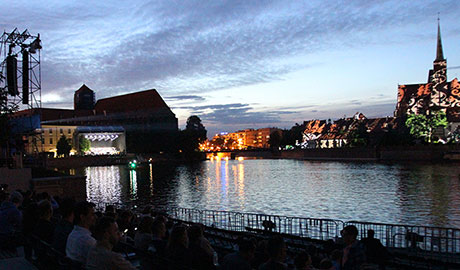 |
| The Yamaha MRX7-D helped to make system control and programming the complex delays very straightforward |
The Polish city of Wroclaw is the 2016 European Capital of Culture, a status which it has celebrated with numerous events. These included the Flow Quartet, which comprised four large scale performances based around the city’s River Odra. These reached a climax in mid-June, with a Yamaha MRX7-D matrix processor managing a huge Nexo loudspeaker system, with mixing by five Yamaha digital consoles.
Titled Bridges, Spirits of Wroclaw, The Flow (I and II) and Niebo, the individual parts of the Flow Quartet have been taking place between June 2015 and December 2016. The highlight was The Flow II, which took place around the River Odra during the evening of 11th June. Featuring 300 performers from several orchestras and musical academies based in Poland, Germany, Israel and the Czech Republic, an audience of over 100,000 enjoyed the specially-commissioned work of five composers.
Nexo and Yamaha audio systems deployed
The audio production for the event was supplied by leading Polish rental company PogoArt and featured 14 PA towers of Nexo STM M28 loudspeakers, with CD18 subs. The system’s NXAMP4x4 amplifiers were all fitted with Dante cards, allowing the entire audio production to be Dante networked. This featured 34 separate feeds, which were managed by a Yamaha MRX7-D matrix processor.
Yamaha applications engineer Pawel Zachanowicz worked closely with Nexo systems technician Val Gilbert and PogoArt’s Slawek Pogorzala on the system design and setup. “Each signal included eight-band parametric EQ delays. It had to cover an area of the riverside more than 800m long, with some channels needing over 1500ms of delay to ensure that the entire audience enjoyed clear sound. In total the MRX7-D was taking care of more than 10 seconds of delay,” says Pawel.
“Having the whole system on a Dante network meant that we could manage the control and audio routing, while using Nexo speakers on towers meant that the sound would be consistent throughout" |
The sheer scale of the show and number of performers meant that no less than five Yamaha digital consoles were needed to mix it. Six Rio3224-D i/o units routed audio to a CL5, used to mix of all the strings, brass and woodwind, and a CL3 mixing the orchestral percussion and choir. These submixes were routed as groups to a master CL5, which managed the overall front of house mix.
Audio routing with Dante network
The audio groups were also routed to a QL5 for stage monitors, while a QL1 was used for communications between the stage and mix positions, as well as announcements and routing audio to additional systems used with video relays outside the main audience area. Several Ro8 audio output units were also used with Nexo PS series infills close to the main PA towers.
“The biggest challenges of the audio production were having such a vast area to cover and the distance between the stage and Front of House mix position,” says Pawel. “Having the whole system on a Dante network meant that we could manage the control and audio routing, while using Nexo speakers on towers meant that the sound would be consistent throughout."
“The MRX7-D helped to make system control and programming the complex delays very straightforward, ensuring that the show sounded fantastic and was a fitting centrepiece to the 2016 European Capital of Culture celebrations.”




